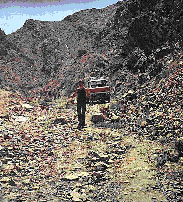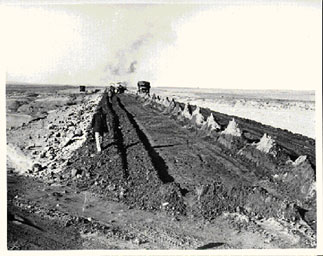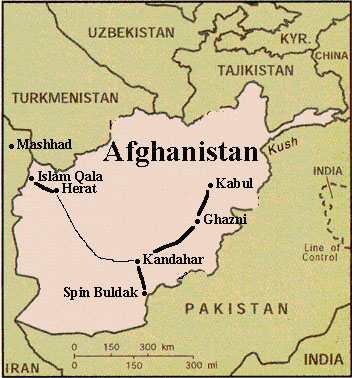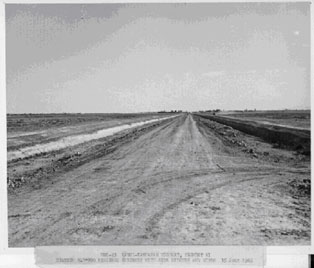The Corps Oversaw the Construction of Much of Afghanistan’s Modern Road Network
 |
| Primitive Afghani road |
As part of an overall effort to promote stronger relations with the indigenous government, counter Soviet influence, and encourage internal trade and political cohesion, during the 1960s the U.S. Army Corps of Engineers oversaw a program to modernize Afghanistan’s primitive system of roads. Throughout this rugged and mountainous country snaked a rudimentary highway system consisting of a 1,700-mile circle of rock-bed and dirt roads linking principal towns and cities. The Gulf District of the Mediterranean Division was tasked with the road-building effort and an Afghanistan Area Office was established at Kabul. To directly supervise the construction, the district activated the Kandahar Resident Office on January 1, 1961.
The Corps’ work on the Afghan highway system began with oversight of the construction of a 96-mile spur from Kandahar southeast to the border with Pakistan at Spin Buldak. On December 1, Henry Byroade, the U.S. Ambassador in Kabul and himself a former Army Engineer officer, formally transferred this road to the government of Afghanistan. The project ultimately cost $3.86 million. While this section had been completed in a relatively rapid manner, the major portion of the Afghanistan highway network, the 300-mile road from Kabul to Kandahar, lagged behind. In the spring of 1961, the Corps awarded a $17.7 million construction contract to Afghanistan Highway Construction (AHC), a consortium of six American construction firms, for the first segments of the roadway. On August 17, AHC launched work on the first segment, a high visibility section from the capital Kabul to the southwest. This segment of 41 miles was the high end of the road, climbing from 6,000 feet at Kabul to 8,300 feet near Ghazni. Work also began on the second segment, a portion rising gently from Kandahar to the higher elevations in the northeast.
Numerous problems plagued this road’s construction, including a border clash between Afghanistan and Pakistan that ultimately restricted construction operations for several years and required the contractor to develop alternate routes for transporting equipment and supplies, principally through Mashhad in Iran to Herat, and then on to Kandahar. In spite of the problems, by May 1962 AHC had completed grading on 10 miles of roadway south of Kabul, and at its opposite end had graded approximately 15 miles. But because of the lack of supplies, AHC could not sustain effective work at two separate locations. Consequently, the district chose to concentrate all work on the second segment from Kandahar. The segment was turned over to the government of Afghanistan on October 29, 1963. The contractor finished neighboring segments ten months later, and by the end of 1964 had completed the initial segment in the north.
 |
 |
 |
| Kabul-Kandahar highway; special subbase finished July 1965 |
Dark lines depict American-built highways |
Kabul-Kandahar highway; subgrade with side ditches and dikes finished July 1965 |
In the meantime, the foundations of road sections at the highest elevations in the middle segments were strengthened, causing moderate delay. It was not until the summer of 1966 that AHC completed the final portion of the highway along with a series of bridges and drainage ditches implemented as ancillary projects. At a July 13 ceremony near Ghazni, King Mohammed Zahir Shah and Secretary of Agriculture Orville L. Freeman marked the turnover of the Kabul-Kandahar highway to Afghanistan. The highway cost a total of $42.9 million, of which $39.3 million came from the United States. The government of Afghanistan paid the balance. The Corps of Engineers collected $4.45 million in fees for engineering, design, supervision, and administration.
 |
|
| Completed section of highway between Kandahar and Herat |
|
The Mediterranean Division oversaw construction of a third highway in Afghanistan—the road running 75 miles west from Herat to the city of Islam Qala on the Iranian frontier. AHC also won that contract and began work on August 27, 1966. By October 12, 1967, all major construction was completed some ten months ahead of schedule. The Afghan government accepted the Herat-Islam Qala road in another formal turnover ceremony the following March. The total cost of constructing the road had risen to $9.5 million, a figure elevated by considerable repair and redesign necessitated by massive flooding.
The Herat-Islam Qala highway, the Kabul-Kandahar highway, and the Kandahar-Spin Buldak highway linked systematically with Russian-built roads. The total U.S. government contribution to this highway system was over $55 million for construction and another $25 million in related costs. The Corps played a major role in providing Afghanistan with a modern highway system during the heyday of the Cold War. Ironically, this impressive system never realized the full aspirations that Corps planners had for it, as after 1979 the road network would be used for military purposes by Soviet forces during their invasion and occupation of the country. In the ensuing warfare over the last generation, the highway network has suffered serious degradation.
Special thanks to Dr. Volker Thewalt, www.thewalt.de/afghanistan/index_e.html
* * *
December 2001